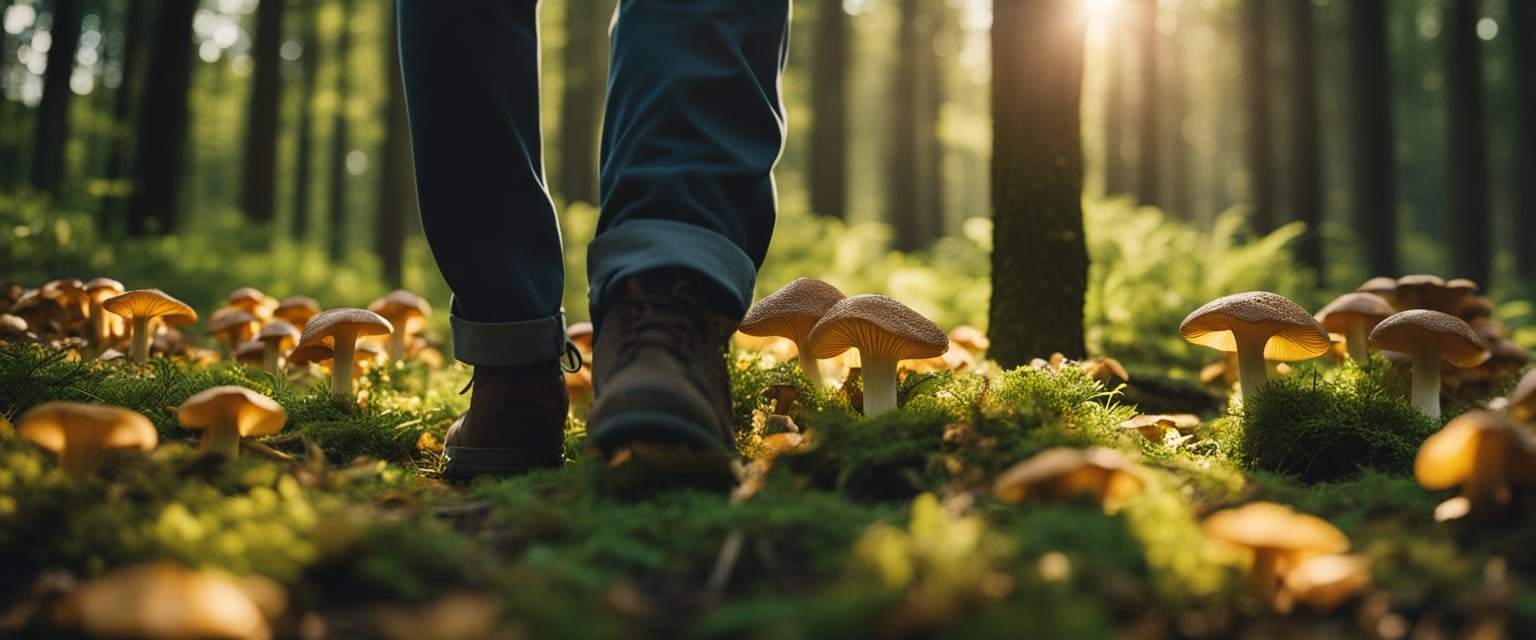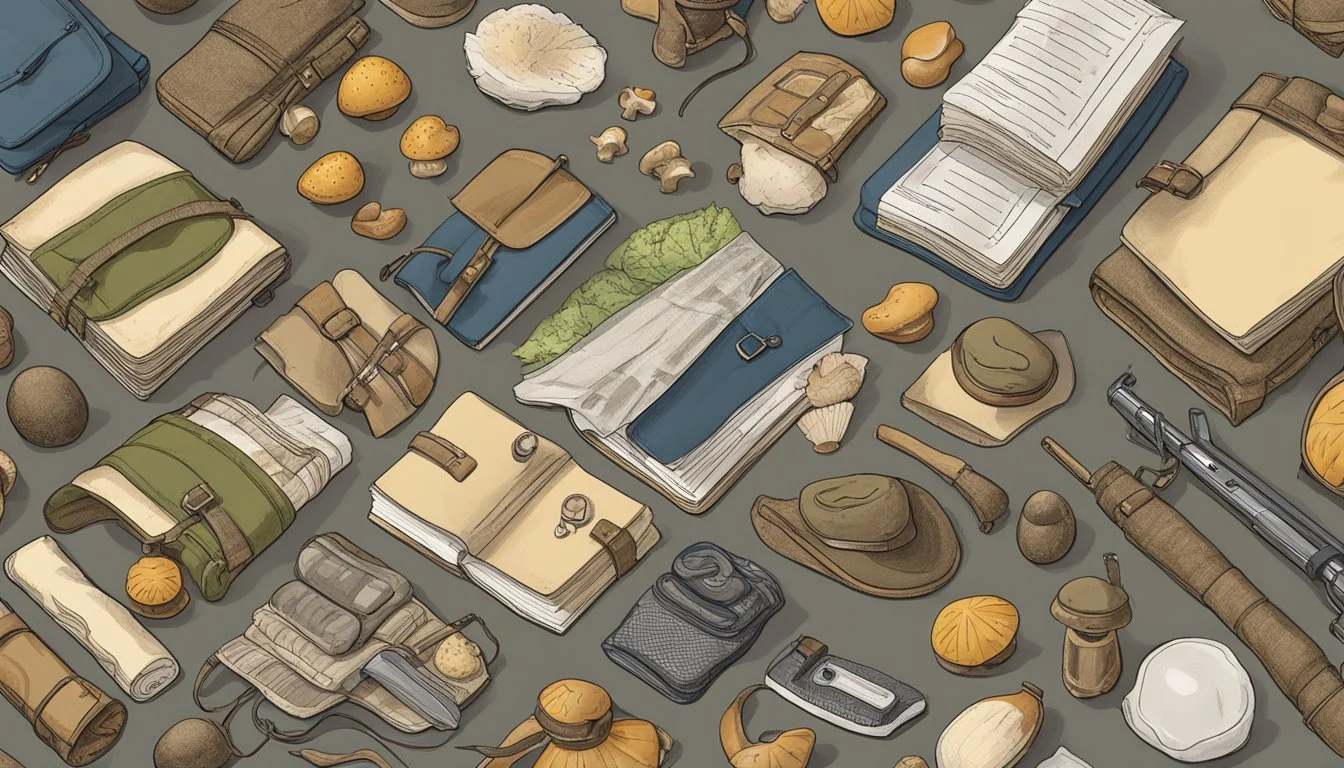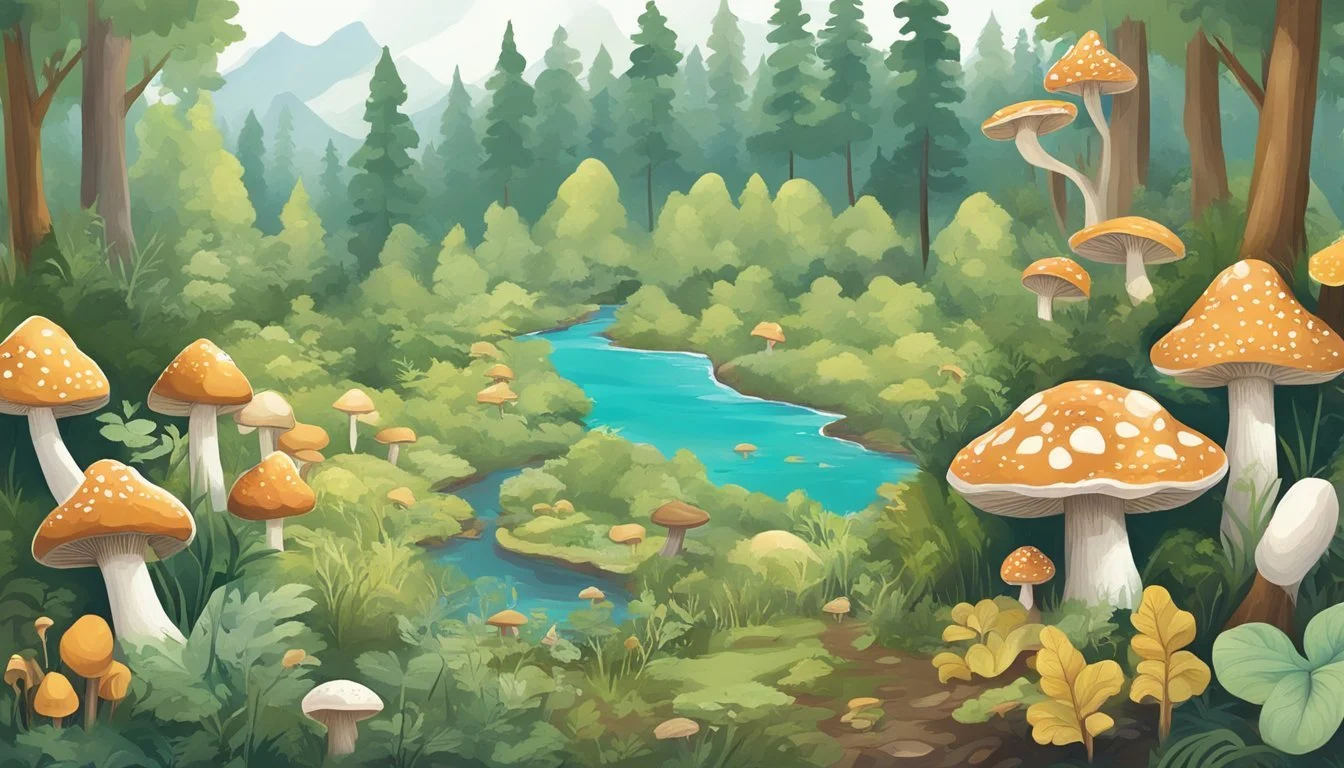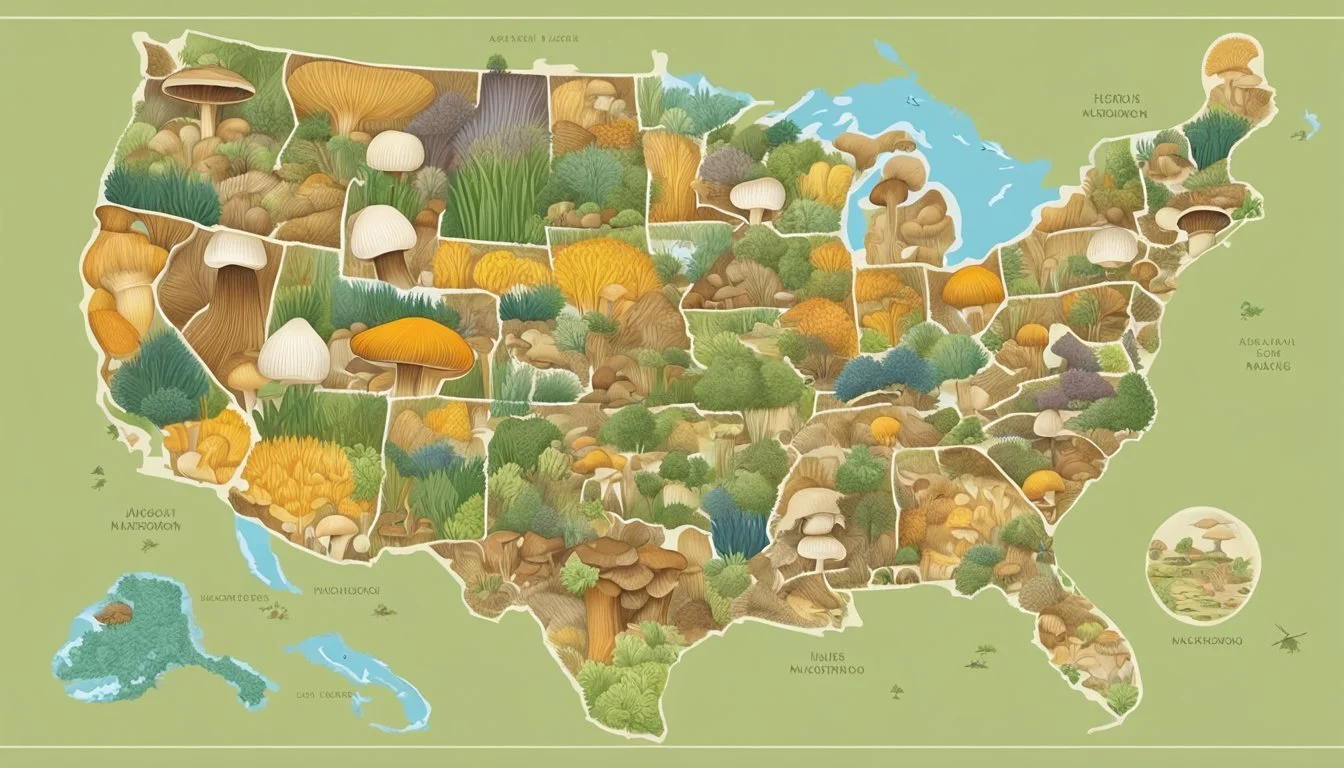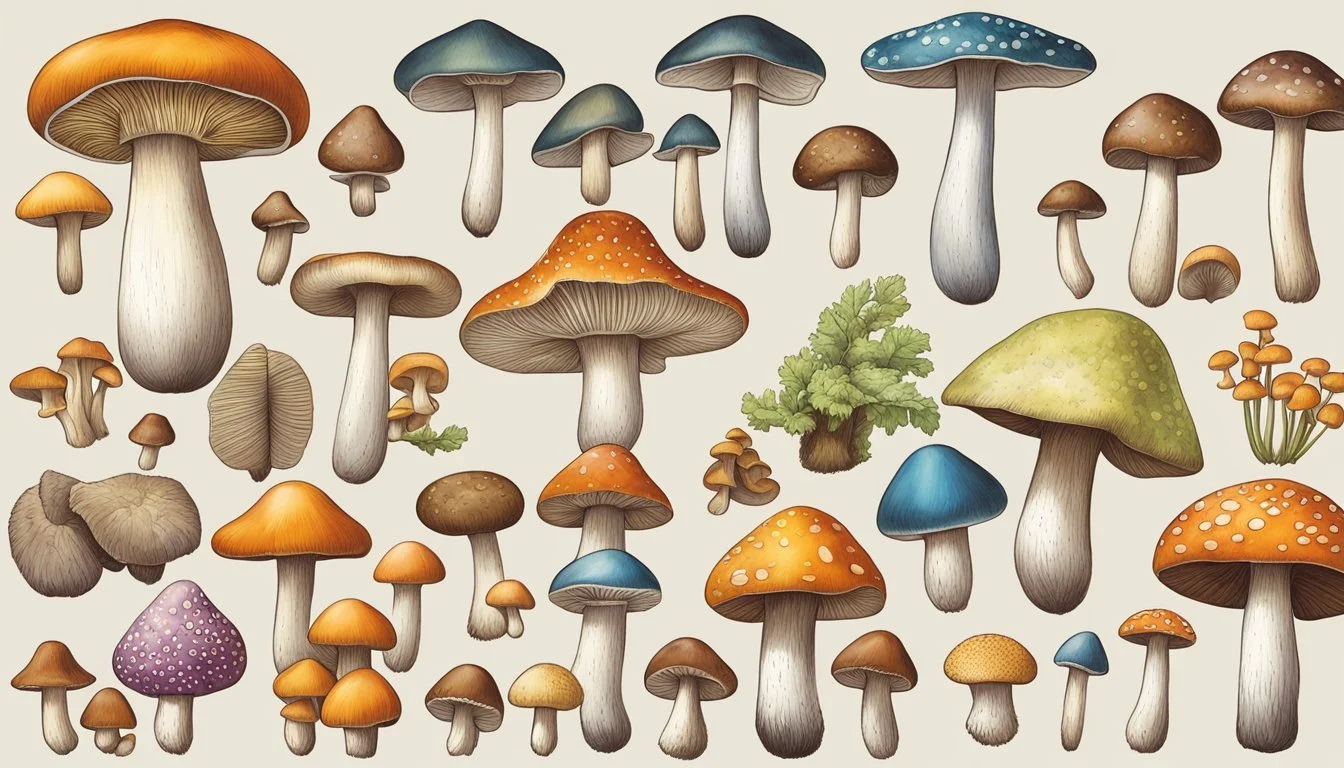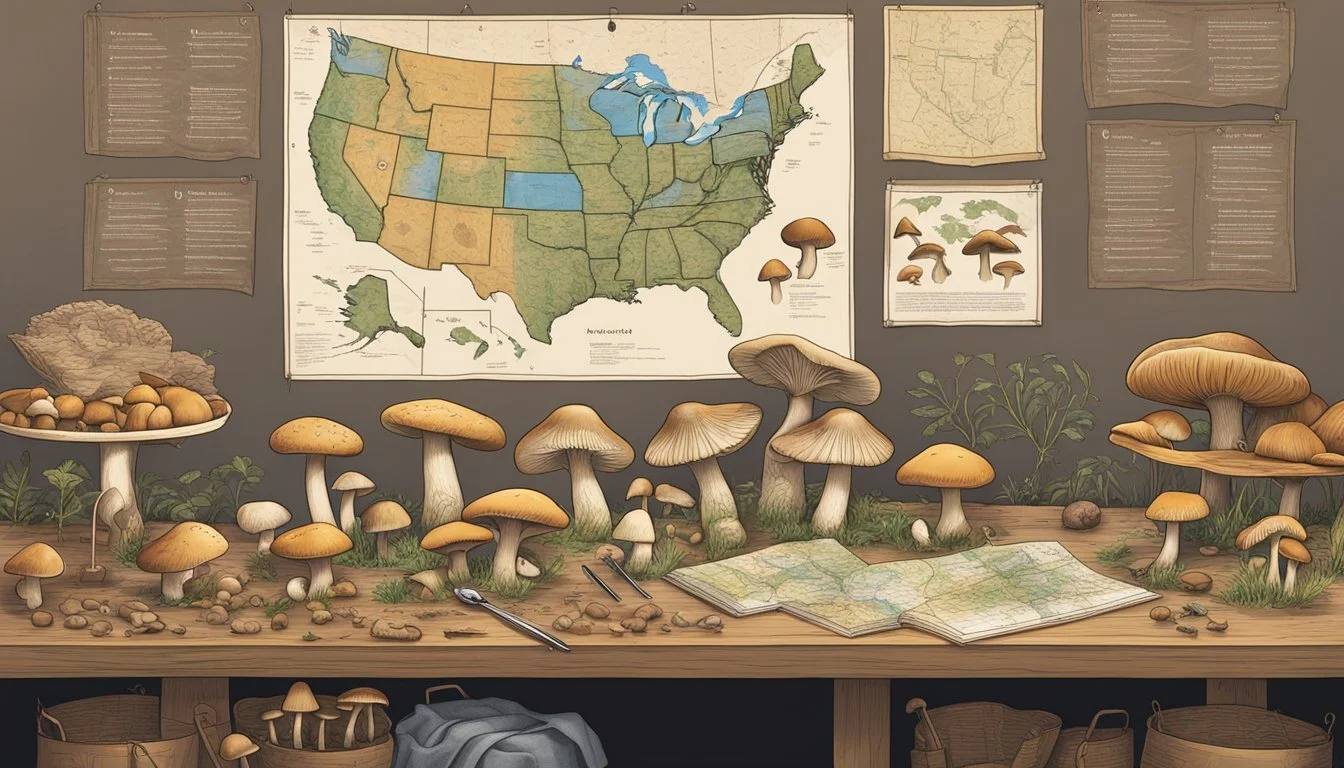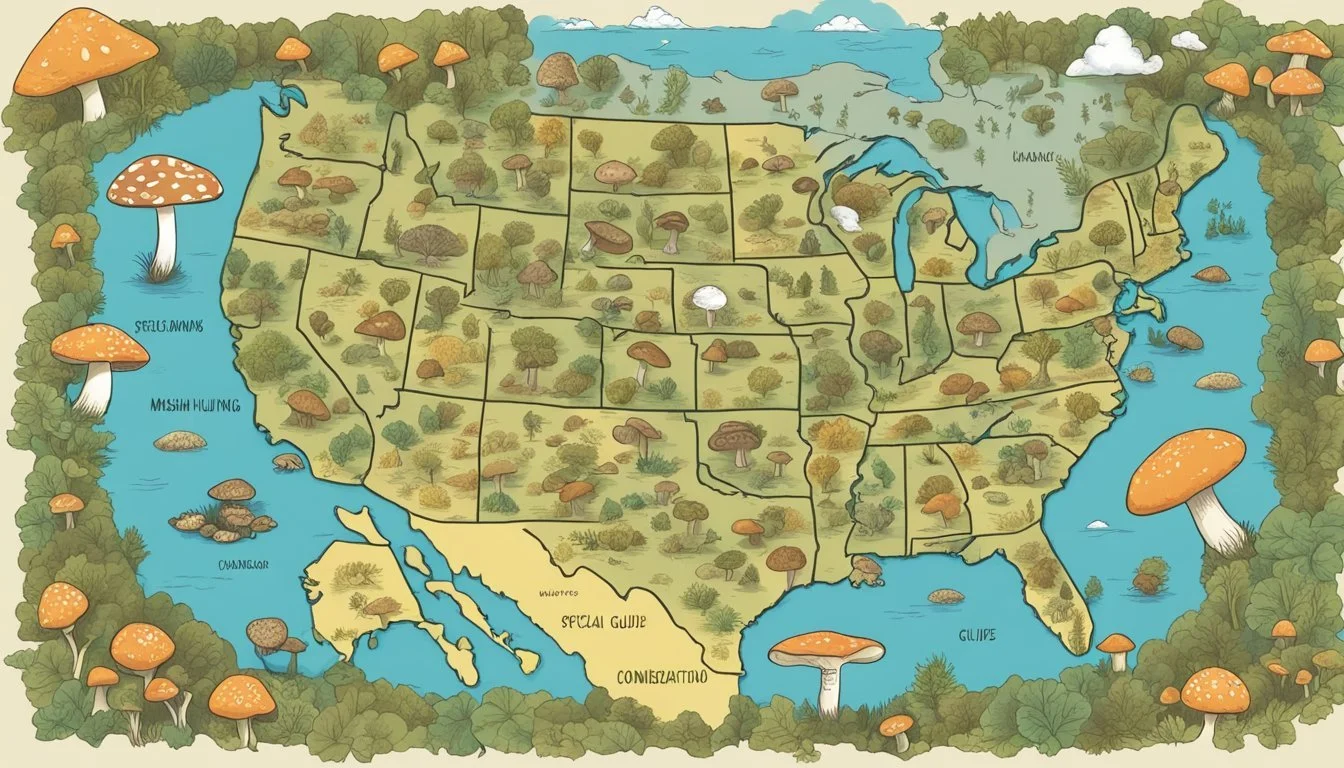Mushroom Hunting Guide for all US 50 States
The Ultimate Foragers' Manual
Discover > Texas Home Cooking > Foraging > Mushroom Hunting Guide for all US 50 States
Mushroom hunting is a rewarding outdoor activity that connects nature enthusiasts with the bounty of the land across the diverse landscapes of the United States. Each state presents its own unique foraging opportunities, shaped by the local climate, geography, and the particular species that thrive there. In the verdant Pacific Northwest, mushroom foragers can find a wide array of fungi, thanks to the damp, mild climate, while the warmer southern states have their season kicking off as early as April, when morels begin to emerge with the arrival of spring temperatures.
To successfully forage for mushrooms, one must understand the intricacies of the environment and the subtle cues that indicate the presence of edible varieties. The ideal time to embark on a mushroom hunting expedition is during the transitional periods of spring and fall, when moisture levels and temperatures are conducive to fungal growth. Mushroom enthusiasts employ tools such as knives or scissors for harvest, and they carry their finds in breathable containers to preserve the mushrooms' (What wine goes well with mushrooms?) integrity.
Mushrooms State by State
Knowledge of local species, weather patterns, and habitat is paramount for a safe and fruitful mushroom hunting experience. Enthusiasts must be vigilant, as some edible mushrooms have toxic look-alikes, making proper identification a matter of utmost importance. The mushroom hunter's creed is one of sustainability and respect for nature, ensuring that these foraging practices can be continued for generations to come.
Alabama
Mushroom hunting is popular in Alabama's forests. Common edible mushrooms include morels, chicken of the woods, and hen of the woods.
👉 Learn More About Mushroom Hunting in Alabama
Alaska
Alaska's wilderness offers a variety of fungi thanks to its diverse landscapes and climate. As the guide from A-Z Animals explains, mushroom varieties include chanterelles, puffballs, and coral fungi. Hunters can find these across the state.
👉 Learn More About Mushroom Hunting in Alaska
Arizona
Mushroom hunting occurs in Arizona's mountain forests. Varieties include morels, chanterelles, and black trumpets. Hunters should wear long sleeves and pants to protect from plants like poison ivy that may be encountered in forest areas.
👉 Learn More About Mushroom Hunting in Arizona
Arkansas
Morel mushroom season runs from March to April in Arkansas according to the Columbia Missourian. Local experts provided tips on timing and locations to find the prized mushrooms.
👉 Learn More About Mushroom Hunting in Arkansas
California
California's varied climate allows for diverse mushroom species across the state's forests and meadows. Popular edible varieties include chanterelles, boletes, and meadow mushrooms. Hunters should obtain proper identification before consumption.
👉 Learn More About Mushroom Hunting in California
Colorado
Colorado's mountains and forests are ideal mushroom habitat. Varieties encountered may include chanterelles, lobster mushrooms, and black trumpets. Hunters are advised to carry a field guide for identification of safe edible fungi.
👉 Learn More About Mushroom Hunting in Colorado
Connecticut
Mushroom hunting occurs in Connecticut's woodlands. Varieties can include morels, chicken of the woods, and oyster mushrooms. Proper identification is important before consuming any wild mushrooms.
👉 Learn More About Mushroom Hunting in Connecticut
Delaware
Delaware's state parks and forests offer habitat for mushroom species. Varieties encountered may include morels, chanterelles, and chicken of the woods. Identification skills are crucial given the state's eastern location.
👉 Learn More About Mushroom Hunting in Delaware
Florida
Florida's wet climate allows for unique tropical mushroom species. Popular edible varieties include fish mushrooms, lion's mane, and chicken of the woods. Identification skills are important given Florida's mix of environments.
👉 Learn More About Mushroom Hunting in Florida
Georgia
Georgia's forests provide habitat for various mushroom species. Varieties encountered could include morels, chicken of the woods, and lobster (What wine goes well with lobster?) mushrooms. Hunters are advised to obtain proper identification before consuming any wild fungi.
👉 Learn More About Mushroom Hunting in Georgia
Hawaii
Hawaii's tropical climate allows for unique mushroom varieties not found elsewhere in the U.S. Edible species include fish mushrooms, lions mane, and nameko. Proper identification is important given Hawaii's exotic mushroom biodiversity.
👉 Learn More About Mushroom Hunting in Hawaii
Idaho
Idaho's mountain forests offer habitat for wild mushroom species. Varieties encountered may include morels, chanterelles, and lobster mushrooms. Hunters are advised to wear long sleeves and pants to protect from plants in forest areas.
👉 Learn More About Mushroom Hunting in Idaho
Illinois
Morel mushroom hunting is popular in Illinois' woodlands during spring according to local experts. Varieties also include chicken of the woods and oyster mushrooms. Proper identification skills are important before consuming any wild mushrooms.
👉 Learn More About Mushroom Hunting in Illinois
Indiana
Morel season runs from April to May in Indiana's forests according to experts. Other edible varieties include chicken of the woods and hen of the woods. Mushroom hunters are advised to obtain landowner permission before foraging.
👉 Learn More About Mushroom Hunting in Indiana
Iowa
Iowa's woodlands provide habitat for morel and chicken of the woods mushrooms during spring. Other edible varieties include puffballs and lion's mane. Hunters should use field guides to properly identify safe mushroom species.
👉 Learn More About Mushroom Hunting in Iowa
Kansas
Kansas' forests and meadows provide habitat for morel mushrooms during spring according to local experts. Other edible varieties include chicken of the woods and puffballs. Proper identification skills are important given Kansas' central location.
👉 Learn More About Mushroom Hunting in Kansas
Kentucky
Kentucky's woodlands are ideal habitat for morel and chicken of the woods mushrooms during spring. Other edible varieties include lobster mushrooms and hen of the woods. Mushroom hunters should use field guides for accurate identification.
👉 Learn More About Mushroom Hunting in Kentucky
Louisiana
Louisiana's wet climate allows for unique tropical mushroom species. Popular edible varieties include oyster mushrooms, chicken of the woods, and black trumpets. Identification skills are important given Louisiana's mix of environments.
👉 Learn More About Mushroom Hunting in Louisiana
Maine
Maine's forests provide habitat for various mushroom species. Varieties encountered could include morels, chicken of the woods, and lobster mushrooms. Hunters are advised to obtain proper identification before consuming any wild fungi.
👉 Learn More About Mushroom Hunting in Maine
Maryland
Maryland's woodlands offer habitat for morel, chicken of the woods and oyster mushrooms during spring. Other edible varieties include lobster mushrooms and puffballs. Proper identification is crucial before consuming wild mushrooms.
👉 Learn More About Mushroom Hunting in Maryland
Massachusetts
Massachusetts' forests provide habitat for morel, chanterelle and lobster mushrooms. Other edible varieties include chicken of the woods and hen of the woods. Identification skills are important given the northeastern climate.
👉 Learn More About Mushroom Hunting in Massachusetts
Michigan
Morel season runs April through May in Michigan's northern forests according to experts. Other edible varieties include chanterelles and chicken of the woods. Proper identification is important before consuming wild mushrooms.
👉 Learn More About Mushroom Hunting in Michigan
Minnesota
Minnesota's northern forests are ideal habitat for morel mushrooms during spring. Other edible varieties include chanterelles and lobster mushrooms. Mushroom hunters should use field guides for accurate identification.
👉 Learn More About Mushroom Hunting in Minnesota
Mississippi
Mississippi's woodlands provide habitat for edible varieties like chicken of the woods, oyster mushrooms, and black trumpets. Proper identification is important given the southeastern climate.
👉 Learn More About Mushroom Hunting in Mississippi
Missouri
Morel season runs from April to May in Missouri's forests according to local experts. Other edible varieties include chicken of the woods and puffballs. Mushroom hunters should obtain landowner permission before foraging.
👉 Learn More About Mushroom Hunting in Missouri
Montana
Montana's mountain forests provide habitat for morel, chanterelle and lobster mushrooms. Other edible varieties include puffballs and chicken of the woods. Hunters are advised to use field guides for identification.
👉 Learn More About Mushroom Hunting in Montana
Nebraska
Nebraska's woodlands provide habitat for morel mushrooms during spring according to experts. Other edible varieties include puffballs and chicken of the woods. Proper identification is important given Nebraska's central location.
👉 Learn More About Mushroom Hunting in Nebraska
Nevada
Nevada's high desert and mountain forests provide habitat for edible varieties like chanterelles, puffballs, and lobster mushrooms. Identification skills are important given Nevada's varied environments.
👉 Learn More About Mushroom Hunting in Nevada
New Hampshire
New Hampshire's forests provide habitat for morel, chanterelle and lobster mushrooms. Other edible varieties include chicken of the woods and hen of the woods. Proper identification is crucial given New Hampshire's northeastern climate.
👉 Learn More About Mushroom Hunting in New Hampshire
New Jersey
New Jersey's woodlands offer habitat for morel, oyster and chicken of the woods mushrooms during spring. Other edible varieties include lobster mushrooms and puffballs. Identification skills are important given New Jersey's location.
👉 Learn More About Mushroom Hunting in New Jersey
New Mexico
New Mexico's mountain forests provide habitat for edible varieties like chanterelles, lobster mushrooms, and chicken of the woods. Identification skills are important given New Mexico's varied environments.
👉 Learn More About Mushroom Hunting in New Mexico
New York
New York's forests provide habitat for morel, lobster and chicken of the woods mushrooms. Other edible varieties include hen of the woods and puffballs. Proper identification is crucial given New York's northeastern climate.
👉 Learn More About Mushroom Hunting in New York
North Carolina
North Carolina's woodlands provide habitat for edible varieties like chicken of the woods, oyster mushrooms, and black trumpets. Proper identification is important given the southeastern climate.
👉 Learn More About Mushroom Hunting in North Carolina
North Dakota
North Dakota's northern forests are ideal habitat for morel mushrooms during spring. Other edible varieties include chanterelles and lobster mushrooms. Mushroom hunters should use field guides for accurate identification.
👉 Learn More About Mushroom Hunting in North Dakota
Ohio
Morel season runs from April to May in Ohio's forests according to local experts. Other edible varieties include chicken of the woods and hen of the woods. Proper identification is important before consuming wild mushrooms.
👉 Learn More About Mushroom Hunting in Ohio
Oklahoma
Oklahoma's forests provide habitat for edible varieties like chicken of the woods, oyster mushrooms, and black trumpets. Identification skills are important given Oklahoma's central location.
👉 Learn More About Mushroom Hunting in Oklahoma
Oregon
Oregon's coastal forests provide habitat for chanterelle, lobster and chicken of the woods mushrooms. Other edible varieties include morels and puffballs. Hunters use field guides for mushroom identification.
👉 Learn More About Mushroom Hunting in Oregon
Pennsylvania
Pennsylvania's woodlands offer habitat for morel, lobster and chicken of the woods mushrooms during spring. Other edible varieties include hen of the woods and puffballs. Proper identification is crucial.
👉 Learn More About Mushroom Hunting in Pennsylvania
Rhode Island
Rhode Island's forests provide habitat for edible varieties like lobster mushrooms, chicken of the woods, and black trumpets. Identification skills are important given the northeastern climate.
👉 Learn More About Mushroom Hunting in Rhode Island
South Carolina
South Carolina's woodlands provide habitat for edible varieties like chicken of the woods, oyster mushrooms, and black trumpets. Proper identification is important given the southeastern climate.
👉 Learn More About Mushroom Hunting in South Carolina
South Dakota
South Dakota's northern forests are ideal habitat for morel mushrooms during spring. Other edible varieties include chanterelles and lobster mushrooms. Mushroom hunters should use field guides for accurate identification.
👉 Learn More About Mushroom Hunting in South Dakota
Tennessee
Tennessee's forests provide habitat for edible varieties like chicken of the woods, oyster mushrooms, and black trumpets. Proper identification is important given Tennessee's central location.
👉 Learn More About Mushroom Hunting in Tennessee
Utah
Utah's mountain forests provide habitat for edible varieties like chanterelles, lobster mushrooms, and chicken of the woods. Identification skills are important given Utah's varied environments.
👉 Learn More About Mushroom Hunting in Utah
Vermont
Vermont's forests provide habitat for morel, chanterelle and lobster mushrooms. Other edible varieties include chicken of the woods and hen of the woods. Proper identification is crucial given Vermont's northeastern climate.
👉 Learn More About Mushroom Hunting in Vermont
Virginia
Virginia's woodlands provide habitat for edible varieties like chicken of the woods, oyster mushrooms, and black trumpets. Proper identification is important given Virginia's location on the east coast.
👉 Learn More About Mushroom Hunting in Virginia
Washington
Washington's coastal forests provide habitat for chanterelle, lobster and chicken of the woods mushrooms. Other edible varieties include morels and puffballs. Hunters use field guides for mushroom identification.
👉 Learn More About Mushroom Hunting in Washington
West Virginia
West Virginia's forests provide habitat for morel, chicken of the woods and lobster mushrooms during spring. Other edible varieties include hen of the woods and puffballs. Proper identification is crucial.
👉 Learn More About Mushroom Hunting in West Virginia
Wisconsin
Wisconsin's northern forests are ideal habitat for morel mushrooms during spring. Other edible varieties include chanterelles and lobster mushrooms. Mushroom hunters should use field guides for accurate identification.
👉 Learn More About Mushroom Hunting in Wisconsin
Wyoming
Wyoming's mountain forests provide habitat for edible varieties like chanterelles, lobster mushrooms, and chicken of the woods. Identification skills are important given Wyoming's varied environments across forests, deserts and high elevations.
👉 Learn More About Mushroom Hunting in Wyoming
Understanding Mushroom Foraging
Mushroom foraging is both an exciting hobby and a skill that requires knowledge, respect for nature, and an awareness of local laws. A meticulous approach to safety, ethics, and regulations ensures a positive experience for foragers across all US states.
Fundamentals of Foraging
When embarking on a mushroom foraging journey, it is crucial for individuals to arm themselves with the right tools and knowledge. A forager must be able to accurately identify mushrooms, as misidentification could have serious consequences. Edible fungi are often similar in appearance to toxic species. Therefore, foragers should invest in a reputable field guide and strongly consider engaging in local education courses to improve recognition skills.
Essential foraging gear includes:
Field guide: To assist with mushroom identification
Knife: To harvest mushrooms without damaging the mycelium
Basket: Allows for air circulation, which can help spores to disperse and potentially propagate new growths
Note-taking tools: For recording details about the foraged mushrooms and locations
Safety and Ethics in Mushroom Hunting
Safety in mushroom foraging operates on two fronts: personal safety in the natural environment, and safety related to consumption. Prior to any foraging expedition, foragers should inform someone of their intended location and return time. They should be equipped with a GPS device or compass, water, snacks, and appropriate attire for varying weather conditions.
Foragers must also practice ethical foraging by adhering to principles such as:
Harvesting selectively: Only taking mushrooms that are well-known and leaving behind the ones uncertain in edibility.
Conservation: Avoiding overharvesting to ensure future growth and ecological balance.
Leave no trace: Minimizing impact on the foraging site to preserve natural habitats.
Legal Considerations and Permits
Mushroom foraging laws vary significantly across the 50 states. Some areas may require a permit for foraging, particularly in state or national parks, whereas others may have looser regulations when foraging for personal use. Foragers should research and understand the legal requirements of the state they are in to avoid any infractions. In some cases, commercial foraging may be heavily regulated or even prohibited.
Permit requirements may include:
Personal use permits: Often free or low-cost and vital for foraging in certain jurisdictions.
Commercial permits: Necessary for individuals intending to sell their bounty and typically entail more strict guidelines.
In summary, safe and legal foraging requires education, thorough research, and a respectful approach to natural resources. Foragers must prioritize safety, adhere to ethical guidelines, and comply with state-specific legal requirements to enjoy the rewarding experience of mushroom foraging.
Preparation for Mushroom Hunting
Proper preparation is crucial for a successful and safe mushroom hunting experience. One must equip themselves with the necessary gear and knowledge to identify both edible and poisonous varieties of mushrooms across all US states.
Essential Gear and Equipment
Mushroom Basket or Mesh Bag: A rigid basket or a mesh bag allows for safe transportation without damaging the mushrooms. They also permit spores to spread, promoting future growth.
Knife: A sharp knife or scissors are used for cleanly cutting the stem, which helps in preserving the fungi's environment and the mushroom itself.
GPS or Compass: Navigation tools such as a GPS or compass are important for safety, especially when hunting in unfamiliar or dense areas.
Field Guide: A detailed field guide with photographs and descriptions helps in mushroom identification on the spot.
Proper Clothing: Weather-appropriate clothing and durable boots protect against elements and rough terrain.
Recognizing Edible Mushrooms
Morel Mushrooms: Morels are distinguishable by their honeycomb-like appearance. They are often found after rain near dying trees.
Oyster Mushrooms: These grow on the sides of trees and have a broad, fan-like shape. They are typically white to grey.
Chanterelles: They are yellow to orange with a fleshy, funnel shape, and found in moist woods.
Hen of the Woods: Also called 'Maitake', they form large clusters at the base of trees, especially oaks.
Identifying Poisonous Varieties
It's essential to be able to distinguish between edible varieties and their poisonous look-alikes. Some poisonous mushrooms can mimic the appearance of their edible counterparts quite closely. For instance:
False morels (poisonous) resemble true morels but have a cottony or solid interior versus the hollow interior of edible morels.
Jack-o'-lantern mushrooms can be mistaken for chanterelles due to their color, but they possess gills and a different growth pattern.
Best Practices for Mushroom Hunting
Mushroom hunting can be a gratifying hobby, rewarding both the palate and the spirit of adventure. Knowing when, where, and how to look for mushrooms increases one's chance of a bountiful harvest. Adhering to best practices ensures safety, sustainability, and success.
Optimal Seasonal Timing
Mushroom season varies by type but commonly aligns with spring and fall, when moderate temperatures and moisture levels promote fungal growth. Hunters should monitor soil temperature as some species have specific requirements. It’s prudent to research the particular mushroom seasons in their state to optimize the timing of their hunting expeditions.
Ideal Mushroom Habitats
Mushrooms thrive in diverse habitats, but forests often offer the richest hunting grounds. Dead trees and rich, damp forest floor environments are prime locations for fungal growth. Mushroom hunters should look for areas with ample shade and moisture, and consider elevation as it can affect the types of mushrooms found. Hikers should seek out areas with:
Decaying wood
Mossy areas
Variations in elevation
Effective Hunting Techniques
Successful mushroom hunting combines preparation with field tactics:
Start with a hike in likely mushroom-rich areas like shady forests.
Bring a field guide to assist in the identification of edible species.
Harvesting should be done carefully to preserve the fungal mycelium for future growth—cut mushrooms at the stem rather than pulling them out.
Use a woven basket or a container with holes to allow spores to spread as you continue your hunt.
Regional Guides
Mushroom hunting can vary significantly by region due to differences in climate, ecology, and species prevalence. Each part of the United States boasts a unique set of conditions favorable to certain types of mushrooms, particularly morels which are highly sought after.
Mushroom Hunting in the Northeast
In the Northeast, morels are often found in proximity to ash, elm, and tulip trees. The foraging season starts in late spring; early indicators include the blooming of lilacs. Hunters should prioritize areas with well-drained soil and partially shaded woods. New England's diverse ecosystem also supports a range of other edible mushrooms beyond just morels.
Midwest Mushroom Foraging
The Midwest is renowned for its abundant morel mushrooms that appear as spring warmth settles in, particularly around dying or dead elm trees, in old apple orchards, and near ash and pine. A key tip for Midwest foragers is to search after a warm rain, which stimulates morel growth. Morels in this region tend to be generous in size, offering a rewarding hunt.
Southern States Fungi Search
Fungi enthusiasts in the Southern states will have the best luck around pine and oak forests as well as river bottoms with sycamore and cottonwood trees. The warmer southern climate means mushroom season starts earlier here, sometimes as soon as late winter. Look for the King Bolete, a prized find in these regions, known for its meaty cap and delicious flavor.
Pacific Northwest Mushrooming
Renowned for its rich biodiversity, the Pacific Northwest is a haven for mushroom foragers. Species like the King Bolete and Chanterelles are abundant, benefitting from the moist, coastal climate. Coniferous forests, often with a mix of pine and fir, provide fertile ground for mushroom growth year-round but especially in the fall. Here, foragers are often rewarded with a variety of both common and rare species.
Mushroom Species by State
The diversity of mushrooms in the United States varies by region and state, influenced by factors such as climate, vegetation, and geographical features. Below is a guide to some of the notable mushroom species found across four states—Michigan, Colorado, Montana, and California—each with their unique habitats and foraging opportunities.
Morel Mushrooms in Michigan
Michigan's damp spring season and proximity to the Great Lakes create an ideal environment for Morel mushrooms to thrive. Enthusiasts often seek these elusive fungi in wooded areas, particularly around ash, elm, and aspen trees. Morels in Michigan are usually found from late April through May, just after the snow melts and the soil warms.
Chanterelles in Colorado
In Colorado, Chanterelles are commonly foraged in the summer months, typically in regions with mixed hardwood forests. The moist conditions of the Cascades support the growth of Chanterelles, which form a symbiotic relationship with the roots of trees. They can often be spotted near oaks and conifers, sporting their distinct yellow to orange coloring.
King Boletes in Montana
King Boletes, known for their thick stems and large, brown caps, are prevalent in Montana, particularly in the coniferous forests near the Rocky Mountains. These prized mushrooms are found during late summer and early fall. Mushroom hunters frequent the areas around lane and lake habitats where King Boletes often emerge.
Oyster Mushrooms in California
California, with its diverse range of ecological zones, is home to Oyster mushrooms. These mushrooms are often found on the dead or dying hardwoods throughout the state. With a preference for cooler coastal temperatures and rainy seasons, Oyster mushrooms in California can be harvested almost year-round, particularly in areas with fallen logs or in forests with ample deciduous trees.
Mushroom Hunting Techniques
Successful mushroom hunters utilize a variety of techniques to improve their yields across the diverse landscapes of the United States. These methods range from understanding different terrains, utilizing tree types to pinpoint mushroom locations, and interpreting environmental clues.
Foraging in Different Terrains
In the varied terrains of the US, mushroom hunters will find levels of success by recognizing the right environments for specific fungi. Fields, with their expansive open areas, can be ideal for finding varieties like morels, especially near areas of decaying matter or disturbed soil. On the other hand, forested areas with a mix of decay and undergrowth are often sweet spots for a plethora of edible mushrooms. Hunters should avoid terrains with cement or overly sandy soil, as these are less conducive to fungal growth.
Using Tree Types to Locate Mushrooms
Tree identification is a critical skill for mushroom hunters. Certain mushrooms have symbiotic relationships with specific trees, making tree types excellent indicators. For example:
Tulip poplar: Known for its association with morels.
Ash: Another tree under which morels might be found.
Apple trees: Often support a variety of edible mushrooms due to the rich organic material available from fallen fruit.
Mushroom hunters should research and carry pictures or charts of trees common to the targeted foraging area to enhance their hunting efficiency.
Responding to Environmental Clues
Mushroom hunters benefit from understanding environmental signals. Mushrooms thrive in moist, warm conditions after rainfall. Paying attention to these conditions can lead hunters to fruitful areas. Additionally, indicators like the presence of skunk cabbage may signal a more fertile mushroom environment. Mushroom hunters should keep an eye on such vegetation changes, as they can lead to the discovery of prime fungi locations. They should also be aware of both the potential for poisonous mushrooms and ecological impacts, ensuring their foraging is both safe and sustainable.
Post-Hunt Practices and Preservation
After the excitement of the hunt, the proper cleaning, preservation, and preparation of mushrooms are key for safe and enjoyable consumption. Precise techniques ensure the longevity and quality of your foraged fungi.
Cleaning and Storing your Find
Once you return from foraging, mushrooms should be inspected and cleaned carefully to remove any dirt, debris, or insects that may be present. They are best stored in breathable containers like wicker baskets or paper bags. If longer storage is needed, freezing is a viable option. For freezing, one should first sauté or blanch the mushrooms and then cool them rapidly in cold water. After draining, they can be stored in freezer containers.
Sautéed mushrooms:
Sauté with a little oil or butter.
Let cool.
Place in a freezer container and freeze.
Blanched mushrooms:
Blanch mushrooms in boiling water.
Immediately immerse in cold water to cool.
Strain and transfer to a freezer-safe container.
Cooking and Consuming Wild Mushrooms
Upon determining which mushrooms are safe and edible, they should be consumed or processed according to best practices to maintain their quality and flavor. It is imperative not to consume any mushrooms unless 100% certain of their edibility, as some species can be toxic. Edible mushrooms can be added directly into dishes from their frozen state; there's no need to thaw them first, ensuring they retain their texture and taste. Cooking methods may vary, but a simple sauté can enhance the flavor of most mushroom varieties.
Educational Resources
Educational resources are fundamental for anyone looking to explore the vast world of mushroom hunting in the United States. The right materials can provide essential information on identification, harvesting, and safety.
Books and Guidebooks
Mushrooms Demystified by David Arora is often considered a seminal work in the field. This comprehensive guide offers detailed descriptions and is an invaluable resource for both beginners and experienced foragers. Another classic by Arora, All That the Rain Promises and More: A Hip Pocket Guide to Western Mushrooms, is a more compact guidebook perfect for quick reference during foraging trips.
For those looking for an up-to-date and accessible option, The Complete Mushroom Hunter by Gary Lincoff provides a modern look at mushroom hunting, complete with vivid photographs and practical advice tailored for foragers across the United States.
Online Forums and Communities
Joining online forums and communities can be incredibly beneficial for mushroom hunters. These platforms are places where individuals can exchange knowledge, learn from others' experiences, and get identification help.
Shroomery: A well-known online forum dedicated to mushrooms, offering a space for discussions on identification, habitat, and cultivation.
Mushroom Observer: This platform allows users to record and share mushroom sightings, fostering a citizen science approach to mycology.
Reddit's r/mycology: A subreddit where enthusiasts and experts alike share their finds, experiences, and knowledge about mushrooms.
These resources serve as educational tools, and individuals should always verify information with local experts to ensure correct identification and safe foraging practices.
Special Considerations
When embarking on mushroom hunting across the United States, foragers should prioritize safety and awareness. Key considerations include the impact of natural events on mushroom proliferation, the presence of wildlife during foraging, and the identification of lookalikes to avoid toxic mistakes.
Hunting After Natural Events
Burn sites often become hotspots for mushroom hunting due to the encouragement of growth, especially for natural morels. Beginners should note that burn morels thrive in these locations the season after a fire. Foragers must check local regulations, as some states require permits to harvest in burn sites.
Foraging with Wildlife
Mushroom hunters share their environment with local fauna. Some wildlife, like turkeys, may lead foragers to fruitful spots, as they scratch the ground, uncovering mushrooms. Maintaining a safe distance and not disrupting the animals is imperative. It's essential for one's safety to be aware of the presence of potentially dangerous wildlife and take appropriate precautions.
Avoiding Mushroom Lookalikes
Foragers must be cautious of mushroom lookalikes. For example, while shaggy manes are edible, their resemblance to some toxic species demands careful identification. Inky caps, another edible variety, also have poisonous lookalikes. Therefore, a rule of thumb for all foragers, especially beginners, is to never consume any mushroom unless they are 100% sure of its identity and edibility.

